March 4, 2022


HUTER establishes the Data set of ~1 mil scRNAseq for endometrium cells at reproductive age to assess variability among individuals
Date: March 4th 2022
HUTER research team presents the first version of the “Data set of scRNAseq for health and preeclamptic endometrial cells at reproductive age to assess variability among individuals”. Three areas are addressed:
- Acquisition and processing of healthy and preeclampsia tissue biopsies.
- Optimization of the bioinformatics pipeline for the scRNAseq analysis.
- Preliminary results from the healthy endometrial biopsies along menstrual cycle and preeclampsia case disease.
The report provides a description of the rigorous experimental process for the endometrial biopsies analysis by single cell technology during this project, as well as the specific bioinformatic pipeline and an overview of the main results.
This report has been developed by INCLIVA in collaboration with the additional partners involved.
Access our last report to learn more at this link
About the Human Uterus Cells Atlas – HUTER
The human uterus is a flagship reproductive organ with profound implications not only in reproduction but also in women´s health. HUTER can advance the Human Cell Atlas initiative for the exploitation potential in Obstetrics and Gynecology and biomedicine research areas such as Regenerative Medicine or Reproductive Medicine.
The uterus is itself a model for regenerative medicine since (i) endometrial tissue regenerates monthly and its transformation is executed through dynamic changes in states and interactions of multiple cell types, and (ii) myometrial tissue has remarkable regenerative capacity and extensive remodelling throughout pregnancy. Hence, the primary motivation HUTER proposal stems from the need to better understand the human uterus in order to more effectively address uterine diseases that impact women ́s health such as myomas or endometriosis and/or might contribute to infertility, infant and maternal mortality and morbidity such as preeclampsia.
HUTER technological and biological platform will be a crucial resource for the scientific and clinical communities to define the cellular basis of health and disease, allowing the rapid development of new diagnosis and prognosis tools and therapeutic advancements in the field.
Link to the project website here

